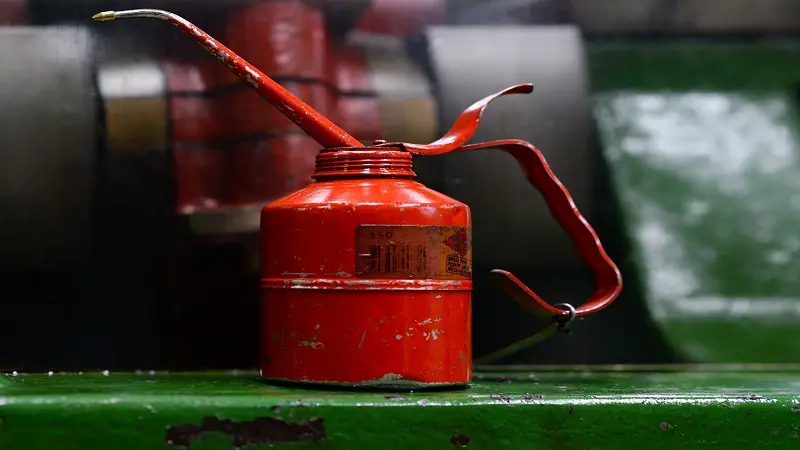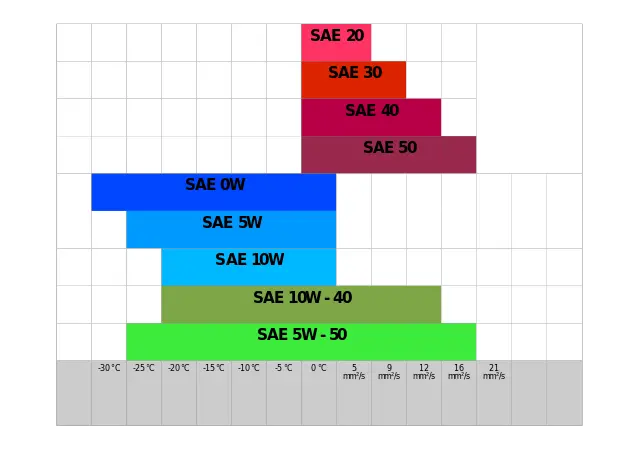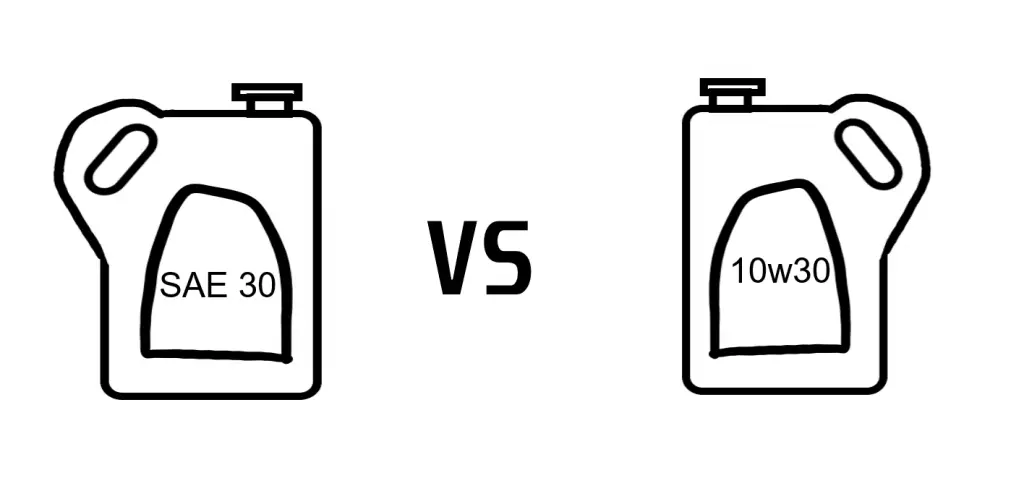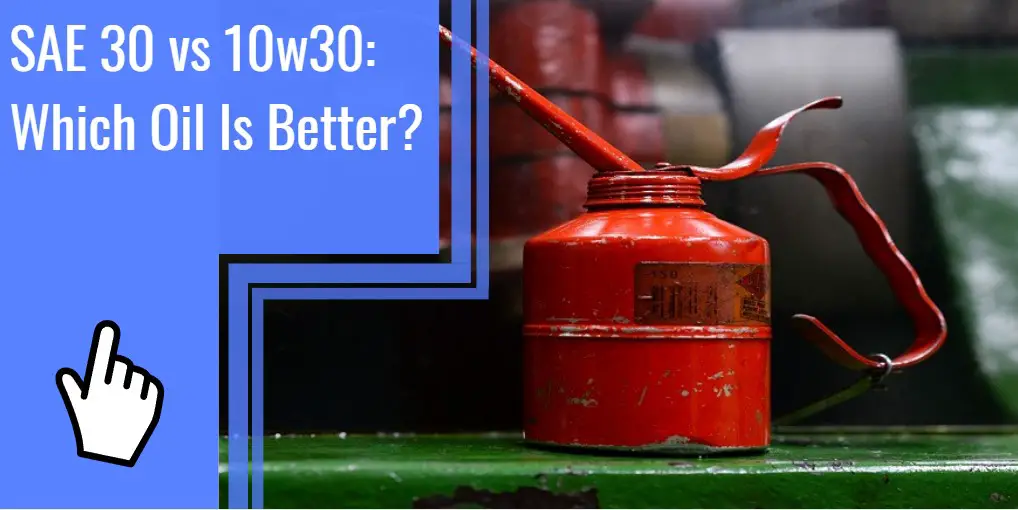What you find on this page:
Whether you are talking about the engine in your car, a lawnmower, a chainsaw, or pretty much anything else, oil is a critical component. The oil acts as a lubricant to engine parts, allowing them to move smoothly. Friction between metal components causes damage and overheating.
In an engine without oil, the moving parts will grind against each other and can cause a seizing up, most likely damaging your engine permanently.
But as you can imagine, not all engines require the same type of oil, and there is a system for classifying oil that tells you which one to buy. The right oil for you depends on the type of engine and the optimal temperature.
And in this article, you will learn about two specific engine oils—SAE 30 and 10w30. You will read about the differences and similarities and whether your situation calls for SAE 30 or 10w30.
What Is SAE 30?
If you’ve been researching what oil to buy for one of your smaller engines, like a lawnmower, you might be wondering to yourself, “what does SAE 30 oil mean?”. And to answer that question, we first have to understand the scientific measurement of viscosity.
The viscosity of a liquid tells you how much resistance it has to movement or changes in shape. In other words, viscosity is the quality of a fluid that resists flowing. So a fluid high in viscosity will be thicker and flow slowly. And a fluid low in viscosity will be thinner and flow quickly.
You’ll learn more detail about the importance of viscosity shortly, but for now, that is enough to understand why SAE 30 has its name and why there is a difference between 10w30 and SAE 30.
SAE is short for the Society of Automotive Engineers, and they are the group that standardizes viscosity ratings in engine oils. The viscosity of motor oils typically falls in the range of 0-100, with a higher number designating a thicker oil. And SAE 30 is the oil that has a standardized viscosity rating of 30 at the standardized operating temperature of 100 degrees Celsius.
Tractors, lawnmowers, chainsaws, and other small air-cooled engines typically use SAE 30, ideal for use at higher temperatures. While a low viscosity works better when you are first starting a cold engine, thin oil can be dangerous at higher operating temperatures.

What Is 10w30?
If you have been researching what oil you should put in your engine, you have also likely run into a different type of engine oil called 10w30. And you might be asking yourself, “is 10w30 the same as SAE 30?”. And which oil wins in a comparison between SAE 10w30 vs SAE 30?
Before comparing SAE 30 vs 10w30, let’s first go over where this other oil gets its name. Similar to the previous oil, the numbers in 10w30 are viscosity measurements. These measurements are also guaranteed by the Society of Automotive Engineers, but it includes an additional viscosity. This addition is the “w” in the name, which stands for winter. It is a measurement of viscosity during colder temperatures.
How can one oil have different viscosities? 10w30 is a double grade oil, and it can therefore have a low viscosity during colder temperatures and a higher viscosity during the hotter operating temperatures. This blending of viscosity is crucial when you need to start an engine in cold weather.
Things About Motor Oil and Engine You Need to Know
You’ve already read about the meaning of viscosity, but let’s now go over the details about why it’s an important consideration for your engines. You already know that an oil higher in viscosity—the higher numbers—flows more slowly. And the thinner oils, viscosities of 5 or 10, flow quickly and can move around your engine easily.
When an engine is running, the oil is moving around the entire engine and keeping everything lubricated. And when you turn off the engine, the oil settles back down into its reservoir storage. Upon restarting the engine, that oil needs to move around the engine again as quickly as possible. And if the oil is too thick, especially in the cold temperatures of winter, then the oil takes a long time to reach its optimal viscosity.
So thinner oil is ideal for lower temperatures. But on the opposite end of the spectrum, there is the problem of the engine being hot. At hotter temperatures, a low viscosity oil does a poor job of properly lubricating and separating engine parts. At high temperatures, thicker oil is ideal.
And that is where a multigrade oil blend like 10w30 comes in handy. By optimizing for cooler and hotter operating temperatures, you can enhance the performance of your engines. By achieving the ideal viscosity for your operating environment, you will decrease your usage of oil and prevent unnecessary wear and tear from aging your engine parts.

What Is the Difference Between SAE 30 and 10w30?
Is SAE 30 oil the same as SAE 10w30 oil? The answer is a complicated yes and no. SAE 30 is engine oil that is single grade, meaning that it only guarantees the stated viscosity at the higher temperature requirements. And at 100 degrees Celsius, both oils have just about the same viscosity—that is why 10w30 oil vs SAE 30 is not a big difference at higher temperatures.
The main difference between these oils is at the lower temperatures, where the viscosities start to differ much more. This difference is because 10w30 motor oil is a multigrade oil, which means that it can maintain an ideal viscosity over a wider temperature range.
For a cold start, the engine prefers a lower viscosity so that the oil can quickly move around and lubricate the engine parts. The “10w” refers to this lower viscosity in “winter” temperatures. And then once your engine heats up to normal operating temperatures, you can expect a similar viscosity rating of 30.
So the main difference between 10w30 and SAE 30 is that one is multigrade and the other is single grade.

Can You Mix SAE 30 and 10w30?
Generally speaking, mixing different oils with different viscosities can be risky, and there is never a guarantee that you will arrive at an acceptable viscosity in the final mix. And this warning against mixing is even more true between single grade and multigrade oils.
While it is probably safe to mix different brands of oils, you should avoid mixing SAE 30 and 10w30 oils. If you need to mix, stick to mixing single-grade oils or multigrade oils with only the same type. It is not advisable to mix a single-grade oil like SAE 30 with a multigrade oil like 10w30.
Which Oil Should I Use for My Lawn Mower?
Lawn mower SAE 10w30 motor oil is probably the most common type of oil used in modern lawn mower engines. It is multigrade and will work well at the lower starting temperatures as well as the higher operating temperatures.
But older engines were indeed designed to be used with SAE 30 oil, and as stated, this will last longer at higher operating temperatures. The thicker oil will also help to protect your lawn mower parts over the long run. In addition, you don’t usually cut the grass during the winter anyway. So SAE 30 is not likely to cause problems in terms of cold startups.
But ultimately, you should read the manual for your specific lawnmower to find out what grade of oil it recommends you use. In almost all cases—and especially for 4-stroke engines—10w30 is the recommended oil to use. A 4-stroke engine has separate filling ports for gasoline and oil, while a 2-stroke engine fills up oil and gas from the same place.
That’s how to decide between SAE 30 vs 10w30 for a lawn mower. Generally, if you have a 4-stroke engine whose manual calls for 10w30, it is probably most ideal to use that or another similar multigrade oil.

Can I Use SAE 30 Instead of 10w30?
While there are some situations where you can get away with using SAE30 instead of 10w30, it is generally not a recommended thing to do. Depending on your engine, for example, if it is a much older engine, you might be able to use a single grade oil like SAE 30 during the hot summer months. You should know, though, that using SAE 30 during cold temperatures is dangerous.
But even during hot temperatures, multigrade oil is still desirable. Most modern engines have a design suited for multigrade oils, and if a thick oil takes too long to lubricate your engine parts, you could be risking permanent damage.

Conclusion: Should I Use SAE 30 or 10w30?
Is SAE 30 the same as 10w30? Hopefully, after reading the article, you have a better understanding of the similarities and differences. When comparing SAE 30 oil vs 10w30, the main consideration is temperature. SAE 30 is more efficient at high operating temperatures.
But if you want an oil that will be optimal at a wide range of operating temperatures, it will be safest to choose the multigrade 10w30 engine oil.
Frequently Asked Questions
It is not recommended to do so. Not only is SAE 30 dangerous during cold temperatures, but your engine might risk permanent damage as well. Here you’ll find all information on what motor oil you should pick (SAE 30 or 10w30)
The main difference between these two oils is the fact that SAE 30 is a single grade engine oil, whereas 10w30 is a multigrade oil. Here you’ll find all differences between the 2 engine oils, and what one u should pick for your engine.





